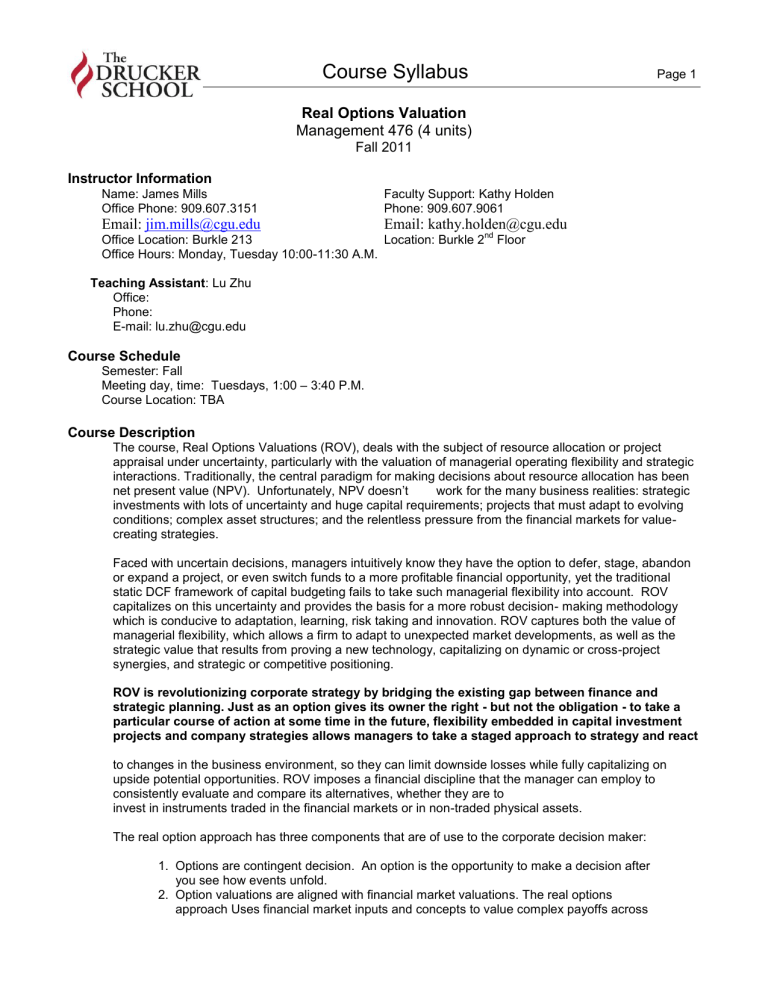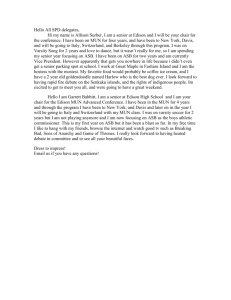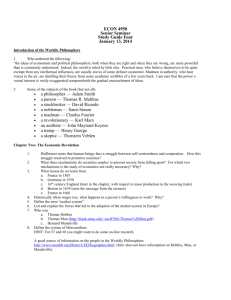Course Syllabus Management 476 (4 units) Email:

Course Syllabus
Page 1
Instructor Information
Name: James Mills
Office Phone: 909.607.3151
Real Options Valuation
Management 476 (4 units)
Fall 2011
Faculty Support: Kathy Holden
Phone: 909.607.9061
Email: jim.mills@cgu.edu
Office Location: Burkle 213
Office Hours: Monday, Tuesday 10:00-11:30 A.M.
Teaching Assistant : Lu Zhu
Office:
Phone:
E-mail: lu.zhu@cgu.edu
Course Schedule
Semester: Fall
Meeting day, time: Tuesdays, 1:00 – 3:40 P.M.
Course Location: TBA
Email: kathy.holden@cgu.edu
Location: Burkle 2 nd
Floor
Course Description
The course, Real Options Valuations (ROV), deals with the subject of resource allocation or project appraisal under uncertainty, particularly with the valuation of managerial operating flexibility and strategic interactions. Traditionally, the central paradigm for making decisions about resource allocation has been net present value (NPV). Unfortunately, NPV doesn’t work for the many business realities: strategic investments with lots of uncertainty and huge capital requirements; projects that must adapt to evolving conditions; complex asset structures; and the relentless pressure from the financial markets for valuecreating strategies.
Faced with uncertain decisions, managers intuitively know they have the option to defer, stage, abandon or expand a project, or even switch funds to a more profitable financial opportunity, yet the traditional static DCF framework of capital budgeting fails to take such managerial flexibility into account. ROV capitalizes on this uncertainty and provides the basis for a more robust decision- making methodology which is conducive to adaptation, learning, risk taking and innovation. ROV captures both the value of managerial flexibility, which allows a firm to adapt to unexpected market developments, as well as the strategic value that results from proving a new technology, capitalizing on dynamic or cross-project synergies, and strategic or competitive positioning.
ROV is revolutionizing corporate strategy by bridging the existing gap between finance and strategic planning. Just as an option gives its owner the right - but not the obligation - to take a particular course of action at some time in the future, flexibility embedded in capital investment projects and company strategies allows managers to take a staged approach to strategy and react to changes in the business environment, so they can limit downside losses while fully capitalizing on upside potential opportunities. ROV imposes a financial discipline that the manager can employ to consistently evaluate and compare its alternatives, whether they are to invest in instruments traded in the financial markets or in non-traded physical assets.
The real option approach has three components that are of use to the corporate decision maker:
1. Options are contingent decision. An option is the opportunity to make a decision after
you see how events unfold.
2. Option valuations are aligned with financial market valuations. The real options
approach Uses financial market inputs and concepts to value complex payoffs across
Course Syllabus
Page 2
all types of real
assets.
3. Option thinking can be used to design and manage strategic investments proactively.
Prerequisites — Classes or Knowledge Required for this Course
Completion of MGT 335 “Corporate Finance” is required and the student should have a very basic knowledge of financial option valuation . Knowledge of advanced mathematical techniques is not a requirement for this course.
Texts and Journal References
Required:
Real Options Analysis , Johnathan Mun, (Wiley Finance), Second Edition - 2006
(hereafter referred to as MUN )
Real Options: A Practitioner’s Guide , Tom Copeland & Vladimir Antikarov (Thomson-
Texere) 2003 (hereafter referred to as CA )
Optional: Suggested resources for your personal library
Real Options: Managing Strategic Investment in an Uncertain World , by Martha
Amram and Nalin Kulatilaka (Harvard Business School Press) 1999
An Applied Course in Real Options, by Richard Shockley (Thomson-Southwester) 2007
Real Options: Managerial Flexibility and Strategy in Resource Allocation , by Lenos
Trigeorgis (MIT Press) 1997
Real Options in Capital Investment , edited by Lenos Trigerogis (Praeger) 1995
Electronic Reserve ( Articles are hereafter designated as JACF#)
“Taking Real Options Beyond the Black Box”, Susan Woolley and Fabio Canizzo,
Journal of Applied Corporate Finance-Volume 17 Number 2, Spring 2005 ( JACF#1 )
“Realizing the Potential of Real Options: Does Theory Meet Practice?”, Alexander Triantis,
Journal of Applied Corporate Finance-Volume 17 Number 2, Spring 2005 ( JACF#2 )
“Real Options Analysis: Where are the Emperor’s Clothes?”, Adam Borison,
Journal of Applied Corporate Finance-Volume 17 Number 2, Spring 2005 ( JACF#3 )
“Real Options: Meeting the Georgetown Challenge”, Thomas Copeland and Vladimir
Antikarov, Journal of Applied Corporate Finance-Volume 17 Number 2, Spring 2005
( JACF#4 )
“A Response Real Options: Meeting the Georgetown Challenge”, Adam Borison, Journal of
Applied Corporate Finance-Volume 17 Number 2, Spring 2005 ( JACF#5 )
“The Case for Real Options Made Simple”, Raul Guerrero, Journal of Applied Corporate
Finance-Volume 19 Number 2, Spring 2007 ( JACF#6 )
“The Role of Real Options in Capital Budgeting” , Robert McDonald, Journal of Applied
Corporate Finance-Volume 18 Number 2, Summer 2006 ( JACF#7 )
“Valuing Assets Using Real Options: An Application to Deregulated Electricity Markets” ,
Gregory Swinand, et.al., Journal of Applied Corporate Finance-Volume 17 Number 2,
Spring 2005 ( JACF#8 )
“Valuing Pharma R&D: The Catch-22 if DCF”, Ralph Villiger and Boris Bodgan, Journal of
Applied Corporate Finance-Volume 17 Number 2, Spring 2005 ( JACF#9 )
“Real OptionsValuation: A Case Study of and E-Commerce Company” , Rocio Saenz-Diez,
et.al., Journal of Applied Corporate Finance-Volume 20 Number 2, Spring 2008
( JACF#10 )
Materials to Purchase on-line
“MW Petroleum Corporation (A)” , by Timothy Luehrman (HBS 9-295-029)
“Capital Projects as Real Options: An Introduction” , by Timothy Luehrman (HBS 9-295-074)
“Investment Opportunities as Real Options: Getting Started on the Numbers” , by Timothy
Luehrman (HBR 98404) July-August 1998
Course Syllabus
Page 3
Videos to Watch: These videos accompany the materials in the test by Mun
Go to www.realoptionsvaluation.com
, downloads, getting started videos
Video A- Real Options Analysis: Basic Theory
Video B- Real Options Analysis: Basic SLS Software
Video C- Risk Simulation: Getting Started
Video D- Risk Simulation: Running Monte Carlo Simulation
Video E- Risk Simulation: Analytical Tools
Lecture Notes, Models, and Problems Sets
Are on the intranet site sakai.claremont.edu. Down load and print out the lecture notes as soon as you can.
You will need the lecture notes for class.
Course Learning Outcomes
Upon completion of this course, the student will learn to:
1. How to make flexible step-by-step decisions and adapt to change to gain competitive
advantage
2. How to take advantage of uncertainty to capitalize on upside opportunities while
limiting downside risk
3. How to translate corporate strategic plans into forward-looking real option value
that enhances shareholders´ wealth and market price
4. How to communicate the advantages of options thinking compared to conventional
discounted cash flow (DCF) analysis
5. How to structure your contracts to leave you valuable flexibility
6. How to quantify the value of strategic investment opportunities
Scientific and Professional Ethics
The work you do in this course must be your own. Feel free to build on, react to, criticize, and analyze the ideas of others but, when you do, make it known by referencing your sources. You must explicitly acknowledge when your work builds on someone else's ideas, including ideas of classmates, professors, and authors you read. If you ever have questions about drawing the line between others' work and your own, ask the course professor who will give you guidance.
While we encourage students to form study groups, any piece of individual assessment must be completed independently. Recycling assignments submitted by students in your class, students in other classes, or students who have previously taken the class or recycling assignments you find in external sources such as the Internet will not be tolerated and will automatically receive a grade of zero. You will also face possible expulsion from the program.
Students with Disabilities
Claremont Graduate University is committed to offering auxiliary aids and services to students with verifiable disabilities, in compliance with section 504 of the Rehabilitation Act of 1973 and Title II of the Americans with
Disabilities Act of 1990. To ensure that individual needs are addressed, students with disabilities are encouraged to contact the Dean of Students.
Grading
Grading practice will adhere to school policy. Grades will be determined on student performance throughout the semester and are not subject to negotiation during or at the end of the semester. Student grades will be determined using the following approximate weights:
1. Examination #1 30.00%
2. Final Exam 30.00%
3. Individual Project
4. Homework
30.00%
10.00%
Course Syllabus
Page 4
Important Dates
Midterm Exam: October 18
Final Exam: December 13
Term paper: November 30
Date/
Class
Subject/Lecture Note Reference/Additional Readings/Cases
Aug. 30
Week 1
Sept. 6
Week 2
Introduction to Real Options
Introduction to Real Options (Section One, Part A)
Real Option Challenges (Section One, Part B)
JACF#2, JACF#3
Video A
Reviewing the Fundaments
Present Value Analysis (Section Two, Part A)
Certainty Equivalence (Section Two, Part B)
JACF#1, JACF#6
Readings/ Exercises
(P)
MUN Ch 1, including appendices
CA Ch 1-2
(P) Ch 1: 4,7,9-11,14
Ch 2: 2-5,7
MUN Ch 2, including appendices
CA Ch 3
(P)
Ch 3:1, 5-7, 9-10
Sept. 13
Week 3
Sept. 20
Week 4
Sept. 27
Week 5
Oct. 4
Week 6
Oct. 11
Week 7
Reviewing the Fundaments
Replicating Portfolios (Section Two, Part C)
Decision Tree Analysis (Section Two, Part D)
Creating the Foundation
Creating a Tracking Portfolio on Financial Assets (Section Three,
Part A)
JACF#4, JACF#5
Creating the Foundation
Creating a Tracking Portfolio on Real Assets (Section Three,
Part B)
From a Tracking Portfolio to Real Options (Section Three, Part C)
JACF#7
Creating the Foundation
From a Tracking Portfolio to Real Options (Section Three, Part C)
Professional and Practitioners Perspectives
Alternative Perspectives to Real Options (Section Four, Part A)
Framing and Valuation Process (Section Four, Part B)
Case Study “MW Petroleum Corporation (A)”
Alternative Methodologies
Closed-Form Solutions (Section Three, Part A)
“Investment Opportunities as Real Options” by Timothy
Leuhrman
“Capital Projects as Real Options” by Timothy Leuhrman
Binomial Lattices (Section Three, Part B)
Alternative Methodologies
Binomial Lattices (Section Three, Part B)
Comparing Methodologies (Section Three, Part C)
MUN: Ch 3, 5
CA: Ch 4, 7
MUN: Ch 6
CA: Ch 4
(P) Ch 4: All
Ch 7: 1-2, 4-6
MUN: 5-6,
CA Ch 7
(P) Ch 8: 5-8
Ch 9: 1-3, 5
Course Syllabus
Page 5
Oct. 18
Week 8
Oct. 25
Week 9
Nov. 1
Week 10
Valuing Real Options
Four Step Process (Section Four, Part A)
Estimating Volatilities (Section Four, Part B)
Mid-term exam
Valuing Real Options
Valuing Simple Real Options (Section Four, Part C)
Valuing Real Options
Power Point Example (Section Six, Part B)
MUN: Ch 4, 12
CA Ch 8
MUN: Ch 7, 8
CA Ch 5,9
(P) Ch 8: 5-8
Ch 9: 1-3, 5
Semi Conductor Plan Example (Section Six, Part c)
Super Lattice and Risk Simulator Software
Video B, Video C, Video D and Video E
Valuing Real Options Nov. 8
Week 11
Nov. 16
Week 12
Nov. 22
Week 13
Nov 30
Week 14
Valuing Complex Real Options (Section Six, Part D)
Super Lattice and Risk Simulator Software
Video B, Video C, Video D and Video E Real Options Case Studies
JACF#8, JACF#9, JACF#10
Real Options Case Studies
Review both the Portes Case and Pharma X
Real Options Case Studies
High-tech Manufacturing
Pharmaceutical Development
Oil & Gas
Employee Stock Options
Real Options Case Studies
High-tech Manufacturing
Pharmaceutical Development
Oil & Gas
Employee Stock Options
Due Date: Project Assignment on Real Options
Real Options Case Studies
High-tech Manufacturing
MUN: Ch 9 + appendices
CA Ch 6
CA Ch 11
CA (P) 1,4-6
MUN: Ch 10
MUN: Ch 11
Dec. 6
Week 15
Dec. 13
Week 16
Pharmaceutical Development
Oil & Gas
Employee Stock Options
Final Exam
**Calendar subject to change
The solutions to the problems in the Copeland and Antikarov text and the Mun text are on electronic reserve. You are expected to work on these problems on your own.
Project Assignment
A key component of this course is an ROV project, where you conduct a strategic analysis and valuation of growth options in a (public or non-public) company of your choice and write a 5-page original report
(Plagiarism will be severely punished!). Using the tools of the course, your analysis will contain evaluation of
Course Syllabus
Page 6 the competitive environment (including uncertainty factors); analysis of the upcoming stages of development and their risks; and a valuation analysis benchmarked to pricing and norms in the financial markets. You may want to use this ROV project to explore already the valuations of lesser known, early stage growth (venture capital?) companies. This project will be something you can show potential or current employers, as a way of introducing your knowledge of advanced strategy and finance skills. The project report is due November 30.




